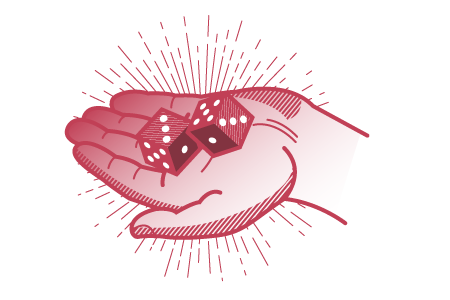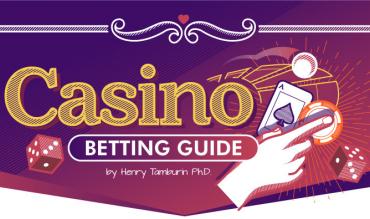
The casino dice game known as craps offers a plethora of betting options. Most have exorbitant house edges but a few are less than 2%. In this guide, I’ll show you how to make the best bets.
COST OF PLAYING
The following table summarizes the house advantage for all the betting options in craps. The house edge represents how much you can expect to lose over time. For example, if you make a bet on Any Craps, which has a house edge of 11.11%, you can expect to lose about $11 for every $100 you bet on this wager.
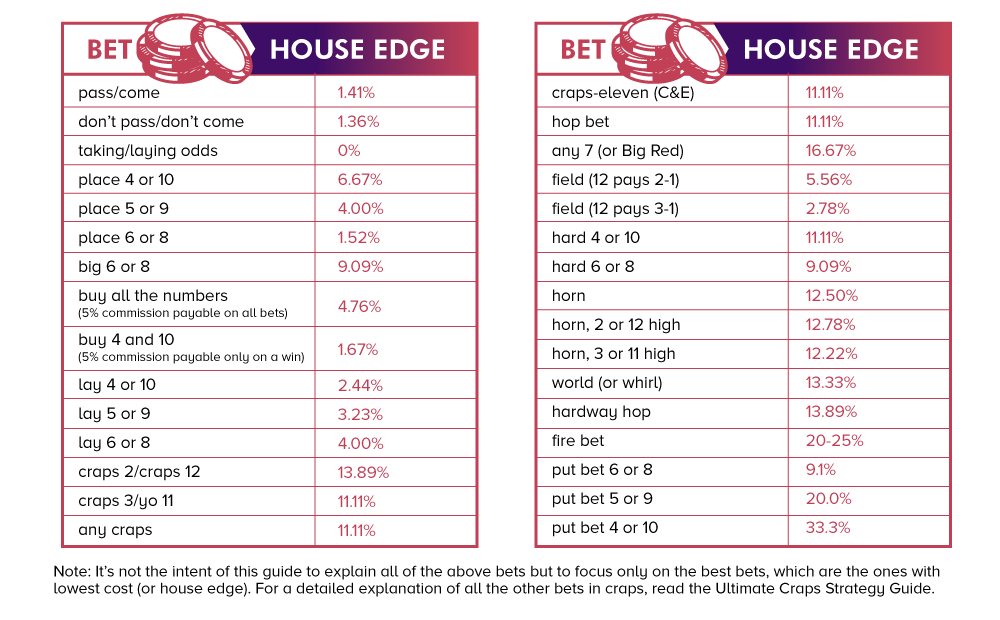
BEST BETS
As you can see in the above table, most craps bets have a hefty house edge. Moreover, there aren’t any magical betting systems (e.g., progressions or hedge betting) that will change this fact. Therefore, your best bets are the ones that have the lowest house edge. They are:

HOW TO MAKE THE PASS LINE AND COME BETS
The game of craps consists of a series of dice rolls. The initial roll by the shooter is called the “come out roll.” You should make your initial bet on the pass line just prior to the come out roll. (The area for making a pass line bet is clearly marked on the craps layout. See the diagram of the layout.)
Let’s suppose you wager a $10 chip on the pass line. After the shooter tosses the dice, the number rolled will be announced by a casino dealer. The pass line bettors will win or lose their bet if one of the following happens on the come out roll:
- It wins on a 7 or 11 (known as “naturals”), or
- It loses on a 2, 3, or 12 (known as the “craps numbers”).
If the shooter throws a natural, everyone betting on the pass line wins and gets paid even money (i.e., if you bet $10, you’ll win $10). Throw craps instead, and all pass line bets lose.
About a third of the time, the shooter will throw naturals or craps on the come out roll. When that happens, pass line bets immediately are settled (i.e., 7 or 11 you win; 2, 3, or 12, you lose). The other two thirds of the time, the shooter will instead throw one of the numbers that appears on the top of the craps layout: 4, 5, 6, 8, 9, or 10. When the latter happens, the number thrown will become the shooters “point number.” The dealer will place a marker (a black and white disc that looks like a hockey puck) in the box at the top of the layout corresponding to the shooter’s point number. (If you were to walk up to craps table and saw the marker lying on the #6 box at the top of the layout, you would know that the shooter’s point is a 6.)
Once a point number is established on the come out roll, the rules change for winning a pass line bet. The shooter must now continue to throw the dice (These rolls are known as point rolls) until one of the following two events occurs.
- If the shooter repeats the point number before throwing a 7, all pass line bets win and are paid at even money.
- If instead the shooter throws a 7 before repeating the point number, then all pass line bets lose.
Keep in mind the following:
- The 7 is a big winner for pass line bettors if it is thrown on the come out roll but if it’s thrown on a point roll, the 7 makes losers of all pass line bettors. (When this occurs, it’s known as “sevening-out.”)
- The 2, 3, 11, and 12 only affect a pass line decision on the come out roll. On point rolls, they have no effect on winning or losing a pass line bet.
Here are several examples of a series of rolls, starting with a come out roll, with the corresponding outcome.

HOW TO MAKE THE ODDS BET
The odds bet (also known as “free odds”) has a zero house edge. That’s the good news. The bad news is that it can’t be made solely in craps; it must be made along with a pass line bet (and, as you will shortly learn, with a don’t pass, come, or don’t come bet).
The reason the odds bet has a zero house edge is because if the bet wins, you are paid at the true odds of making the point number. Thus the odds of rolling a 6 or 8 are 6 to 5 against, and if a shooter wins with 6 or 8 as the point number, all of the odds bets associated with the initial pass line bet are paid at $6 for each $5 bet.
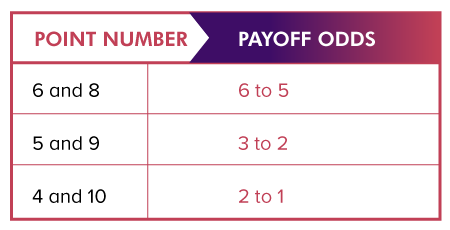
The following table summarizes the payoff odds for the point numbers (which are equivalent to the true odds).
Note: It’s important that when you make an odds wager it is made in multiples of the odds payoff. For example, the correct amount to wager in odds if the point is 6 or 8 is $5 or multiple of $5 (e.g., $10, $15, $20, etc.). If you wagered – say $3 in odds, you would win $3 or even money, meaning you won’t get the full odds payout. Likewise, always wager an even amount on odds if the point is 5 or 9.
So let’s recap. Say you wagered $5 on the pass line and the point was a 6, and you wagered another $5 on the odds. If the 6 is rolled before a 7 appears, you would win $5 for the initial $5 pass line bet and $6 for the $5 odds bet for a total of win of $11. There is something else you need to know about the odds bet before I explain how to make it; namely, what is known as multiple odds.
CASINO’S EDGE WITH MULTIPLE ODDS
When you match the amount of your wager on the pass line with an equivalent amount in odds, this is known as single odds. Because of intense competition among casinos for craps players, many casinos offer what is known as “multiple odds.”
The most common multiple odds offered in casinos are known as double odds in which you are allowed to wager double the amount of your original pass line wager as odds. Some casinos may allow up to triple odds, others 5x, 10x, or even up to 100x your pass line bet. The more you can wager in odds in relation to the pass line wager, the lower the house edge on the combined pass line with odds bets as shown in the following table.
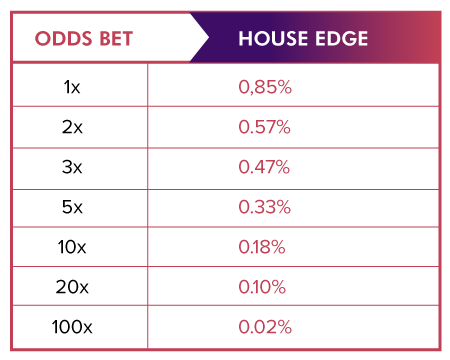
As you can see, the house edge decreases as the multiple odds increase. However, a word of caution: wagering double, triple or more odds requires that you have a sufficient bankroll since a single roll of 7 on a point roll will wipe out your pass line bet (and as you’ll see shortly, all you come point bets along with the secondary odds bet).
BEST WAY TO MAKE THE ODDS BET
If you normally wager, say $20, on the pass line (house edge 1.41%), it’s best to, instead, wager the table minimum on the pass line, for example $5, and then place a $15 triple odds wager. The total amount wagered is the same ($20) but with the $15 triple odds portion of your total $20 bet, you’ll be facing a lower house edge (0.47%) vs. wagering the entire $20 on the pass line (1.41% house edge).
HOW TO MAKE THE ODDS BET
You make the odds bet by positioning your chip(s) directly behind the bet you wagered on the pass line. (As you stand on the craps table, the chips for the odds bet are between you and the chips wagered on the pass line.) You can remove the odds bet at any time (which you shouldn’t do); however, once you make a pass line bet, it can’t be removed (i.e., it stays until it either wins or losses).
BEST WAY TO BET THE PASS LINE WITH ODDS
Most craps players tend to increase the size of their bets after each win to try to capitalize on a “hot roll.” (That’s when a shooter throws a long series of rolls without sevening-out on a point roll.) My suggestion is to bet as follows.
- Bet the table minimum on the pass line. Once a point is established, start with a single odds wager.
- If the pass line bet wins, keep your wager at the table minimum and increase your odds bet to double.
- Continue to increase the amount of the odds bet as you continue to win your pass line bets. Depending on how aggressive you want to be, you can either increase the odds bet in this sequence 1x–2x–3x–4x –5x etc. or a more conservative 1x–2x–2x–3x–3x–4x–4x etc. Once you have a losing roll (i.e., shooter sevens out), decrease your odds on the next point number to single odds and start the betting progression over.
The point of this betting strategy is that you will be increasing your bets on the odds, which have no casino advantage, rather than increasing your bet on the pass line, which has a 1.41% house edge.
COME BETS
Come bets win and lose the same as the pass line except come bets are made on point rolls. You’ll see an area on the craps layout labeled COME (see diagram), which is where you will place your chips for a come wager. Here is an example of how to make a come bet along with a pass line bet.
- On the initial come out roll, you wager, say, $10 on the pass line.
- Assume the next roll was a 10, establishing the 10 as the point number for the pass line. You then make a $10 single odds bet along with additional $10 bet in the come.
- The shooter throws a 10. The pass line and odds bet win. You get paid $10 for the winning $10 bet (even money payout) and $20 (2 to 1 payout) for the $10 odds bet. That settles the initial wager on the pass line. However, the 10 becomes the point number for your come bet and the dealer will move your come bet into the number 10 box at the top of the layout.
- To make the odds bet on your 10 come bet, just place $10 in chips in the come area, get the dealer’s attention, and tell him or her to “put odds on my 10.” The dealer will position your $10 odds bet on top of (but slightly off centered) the initial $10 in chips that are in the 10 box. On subsequent rolls, your come bet with odds will win if the shooter rolls a 10 before a 7, or lose if a 7 is a rolled before a 10 shows. But let’s keep this sequence of dice rolls going.
- Before the next come out roll, you make another $10 bet on the pass line. The next roll is an 11. Your pass line bet wins. (The 11 has no effect on your come bet on the number 10.)
- You wager another $10 on the pass line and the come out roll is a 6. This becomes the shooter’s new point. You bet $10 in odds and make another $10 come bet. On the next roll the shooter throws an 8 so you place $10 in odds in the come and tell the dealer you want those chips on the 8.
At this point, you have two bets working: pass line with odds and one come bet with odds. However, I would suggest you begin with only a pass line with odds bets and then after you are comfortable making these bets, make one come bet with odds. I wouldn’t make more than two come bets with odds simply because you could lose all of your bets with a single roll of a seven.
DON’T PASS AND DON’T COME
The don’t pass and don’t come are the opposite of the pass line and come; namely, you will be hoping the shooter sevens out rather than making the point number. The majority of craps players will wager with the shooter by making pass line and come bets; however, some players, known as “darksiders,” will wager against the shooter by betting on the don’t pass and don’t come. You can use the same concept of betting the table minimum on these bets followed by using the increase odds method described above for with odds.
There are two important points to keep in mind if you decide to wager against the shooter.
- On the come out roll, a 12 is a push for don’t pass bettors.
- When you make an odds wager, you will be laying the odds as opposed to taking the odds as you do with the pass line wager. This means you will be betting more in odds to win less since the don’t bettor has the advantage once a point is established. (For example, if the point was a 6 and you had wagered $5 on don’t pass, you would lay $6 in odds to win $5.)
- The house edge is slightly lower for the don’t pass and don’t come than the opposite pass line and come. For example, with single odds the pass line house edge is 0.85% vs 0.68% for don’t pass. The house edge is also slightly lower for double, triple, etc. odds compared to the corresponding pass/come bets with similar odds.
Again for more details on betting the don’t pass and don’t come, I suggest reading the Ultimate Craps Strategy Guide.
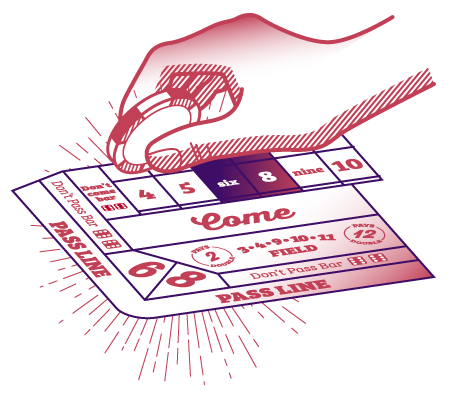
BETTING THE 6 AND 8
There are several ways to bet on the numbers 6 and 8 in craps: Place Bet, Buy Bet, and the Big Six and Eight. The best way is to make the Place Bet on the 6 or 8 because it has the lowest house edge (1.52%).
A Place Bet on 6 or 8 wins and losses as follows:
- Wins if the 6 (or 8) repeats before a 7 appears. Payoff is 7 to 6 meaning for every $6 you wager you win $7. (This is why you should always wager $6, or multiple of $6, when you make the 6 or 8 Place Bet.)
- Loses if a 7 appears before the 6 (or 8) appears.
You can make the 6 and 8 Place Bet at any time and also tell the dealer to “take down my place bet on 6 (or 8)” at any time.
I would use a similar concept of betting the Place Bet on either (or both) of the 6 and 8; namely, bet the minimum then increase your bets on winning coups in a step-wise manner. For example $6–$6–$12–$12–$18–$18–etc.
My recommendation is to stick with the pass line and one (or two) come bets all with odds, and if the 6 or 8 is not covered as a point number for pass line or come bet, then you can consider making the place bet on 6 or 8.
DICE CONTROL
I’d be remiss if I didn’t mention this technique, which could give a craps player the edge. Dice control is a physical skill in which a shooter initially sets and then throws the dice in a specific way to decrease the frequency of the 7s and increase the frequency of the point numbers. However, dice control is a skill that requires hundreds of hours of practice to master. If you are interested to read about my adventures with dice control, I recommend you read my article here.
